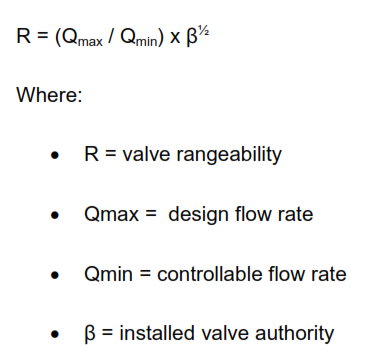Turndown - It is the ratio between maximum usable flow and the minimum controllable flow; usually less than the rangeability.
Valve Turndown Ratio
For instance, as stated above, after the 100 GPM valve has been applied at a job, it might turn out that the most flow you would ever need through the valve is 68 GPM.
Since the minimum controllable flow is 2 GPM, the turndown for this valve is 34 to 1. In comparing rangeability and turndown, we may say that rangeability is a measure of the predicted stability of the control valve, and turndown is a measure of the actual stability of the valve.
Note:
The term rangeability applies to the valve whereas the term turndown applies to the application. The rangeability of the selected valve must exceed the turndown requirements of the application. Mathematically we can define rangeablity as:

The minimum controllable flow rate through a valve is a function of the valve design. It is directly affected by all sources of friction within the valve assembly.
In an ideal valve, any change in the signal applied to the actuator, even an infinitely small change, will force the valve stem to move, even if that movement is infinitely small.
However, friction represents a force that must be overcome by the actuator. When the actuator exerts sufficient force to overcome friction, the valve stem will move some finite amount. When this occurs when the valve is fully closed, this finite movement results in a certain minimum flow rate.